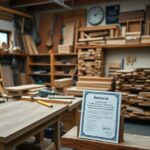Your woodworking business faces unique risks every day, and knowing how to navigate the insurance claims process can make a difference when accidents occur.
Whether you’re dealing with damaged equipment, workplace injuries, or client property issues, filing an insurance claim requires careful attention to detail and proper documentation.
Understanding the steps involved helps you protect your business and ensure a smooth claims experience. This guide will walk you through the necessary elements of filing woodworking-related insurance claims and help you maximize your coverage benefits.
Types of Insurance Claims
Before filing an insurance claim for your woodworking business, you need to identify the specific type of claim that matches your situation. Common types include:
- Property damage to tools and equipment
- Workshop structural damage
- Personal injury coverage
- Third-party liability claims
- Business interruption
Perceiving the correct category helps streamline your claims process and ensures proper coverage.
| Claim Type | Coverage Details |
|---|---|
| Property Damage | Tools, machinery, materials |
| Personal Liability | Injuries, accidents to others |
| Workshop Coverage | Building, workspace damage |
| Business Interruption | Loss of income during repairs |
| Professional Liability | Project errors, quality issues |
Property Damage
By protecting your woodworking assets, property damage coverage safeguards your tools, equipment, and workshop space. You can file claims for incidents like fire damage, theft, or water damage affecting your workspace. This coverage ensures you can replace or repair damaged items quickly to maintain business operations.
Personal Liability
Against potential accidents or injuries to clients or visitors in your workshop, personal liability coverage provides vital protection.
You’re covered for medical expenses, legal fees, and settlement costs if someone gets injured while visiting your workspace or using your products.
This type of coverage extends beyond basic accident protection. You’ll have financial security when facing lawsuits related to your woodworking activities, including product liability claims.
Your policy can cover defense costs, settlements, and judgments up to your coverage limits, helping you maintain your business reputation and financial stability.

Documentation Requirements
Even the most careful woodworkers need to understand proper documentation for insurance claims. Your ability to receive compensation relies heavily on maintaining detailed records of your workshop activities, tools, and safety protocols.
You’ll need to prepare comprehensive documentation that includes incident reports, photographic evidence, and relevant receipts to support your claim.
Incident Reports
The incident report forms the foundation of your insurance claim. You must complete this document within 24 hours of the event, providing specific details about what happened, when it occurred, and who was involved.
Your report should include information about the tools or machinery involved, any safety measures in place, and the sequence of events leading to the incident.
Photo Evidence
Around 80% of successful claims include clear photographic documentation. You should capture detailed images of the damage from multiple angles, ensuring good lighting and focus.
Your photos need to show both close-up details and wider shots that establish the context of the incident in your workshop.
Hence, you’ll want to maintain a systematic approach to your photo documentation. Your images should include timestamps and clear identification markers.
You should photograph any contributing factors, such as equipment malfunctions or environmental conditions, and store these images in both digital and printed formats for your records.
Filing Procedures
Now you need to follow a systematic approach to file your woodworking insurance claim. Your prompt action and attention to detail will help streamline the process and increase the likelihood of a successful claim. Understanding the proper filing procedures specific to woodworking incidents will guide you through each step effectively.
Initial Notification
Along with discovering damage or loss in your woodworking business, you should contact your insurance provider immediately.
Your quick response allows the insurer to start processing your claim and provide guidance on next steps. Make sure to document the incident with photos and notes before any cleanup or repairs begin.
Claim Forms
About the claim forms – you’ll need to complete several documents specific to woodworking incidents. Your insurance provider will supply the necessary paperwork, which typically includes detailed descriptions of damaged equipment, materials, or projects.
You must provide accurate information about the incident, including dates, circumstances, and estimated losses.
At this stage, you’ll want to gather all supporting documentation for your claim. This includes receipts for damaged tools or materials, photos of the incident, maintenance records, and any relevant business records.
Your thorough documentation will help substantiate your claim and potentially speed up the processing time.
Assessment Process
Many insurance claims for woodworking incidents follow a structured assessment path. You’ll need to document all damaged items, tools, and machinery before the adjuster arrives.
Your preparation should include photographs, purchase receipts, and a detailed list of affected equipment. This documentation helps streamline the evaluation process and supports your claim’s validity.
Insurance Adjuster Visits
Between filing your claim and receiving compensation, an insurance adjuster will visit your workshop. You should expect them to examine the damage firsthand, take their own photos, and ask detailed questions about the incident.
Your thorough documentation and clear explanation of events will help the adjuster accurately assess your claim.
Damage Evaluation
Above all, the evaluation focuses on determining the extent of damage to your woodworking equipment and materials. You’ll need to provide access to all affected areas and items. Your adjuster will assess whether repairs are possible or if replacement is necessary, considering factors like age, condition, and market value.
To ensure a fair evaluation, you should maintain detailed maintenance records of your equipment and keep an updated inventory of your tools.
Your knowledge of equipment specifications and current market prices will help support your claim. The adjuster may also consult with woodworking specialists to verify repair costs or replacement values.
Common Claim Scenarios
Not all woodworking insurance claims are created equal, and understanding the typical scenarios can help you prepare better documentation.
Your claims typically fall into categories like tool theft, equipment damage, workshop accidents, and property damage. Being familiar with these scenarios allows you to maintain proper records and respond quickly when incidents occur.
Tool Theft
For your woodworking business, tool theft represents one of the most frequent claim types. You’ll need to maintain detailed inventory lists with serial numbers, photographs, and purchase receipts of your tools. When filing a theft claim, your documentation should include a police report, specific details about the incident, and proof of forced entry if applicable.
Workshop Accidents
Around 60% of workshop-related claims involve injuries from power tools or machinery. When accidents occur in your workshop, you’ll need to document the incident immediately, including photographs, witness statements, and medical reports.
Your insurance provider requires detailed information about safety protocols in place and any preventive measures taken.
Hence, maintaining a well-documented safety protocol and regular equipment maintenance schedule strengthens your position during claims processing.
You should keep records of all safety training, equipment inspections, and maintenance procedures.
Your workshop’s layout, emergency protocols, and first-aid procedures also play a significant role in claim assessment.
Settlement Process
Despite the complexity of insurance claims, your woodworking claim settlement follows a structured approach.
You’ll receive a formal settlement offer after the insurance company evaluates your documented losses, including damaged equipment, materials, and potential business interruption costs.
Your adjuster will explain the coverage limits and any applicable deductibles before finalizing the settlement amount.
Negotiations
Around 40% of initial settlement offers can be negotiated higher. You have the right to counter the insurance company’s first proposal if you believe it doesn’t fully cover your losses.
Your detailed documentation, including receipts, professional appraisals, and market value assessments of your woodworking equipment, will strengthen your negotiating position.
Payment Methods
Along with your settlement agreement, you’ll receive options for payment distribution. Your insurance company typically offers direct deposit, electronic transfer, or traditional checks.
The payment method you choose can affect how quickly you can access your funds and resume your woodworking operations.
For instance, while direct deposit usually provides the fastest access to your settlement funds, you might prefer a check if you’re planning to establish a separate account for business recovery.
Electronic transfers often work best for larger settlements, allowing you to avoid check-clearing delays and immediately start replacing your damaged woodworking equipment or materials.
Summing up
Drawing together, your success in filing woodworking insurance claims depends on maintaining detailed documentation and following proper procedures.
You’ll need to photograph damage, gather receipts, and report incidents promptly to your insurer. Your thorough understanding of policy coverage and deductibles will help streamline the process.
By keeping accurate records of your tools, materials, and projects, you position yourself for smoother claim settlements.
When you establish good communication with your insurance provider and follow their specific filing requirements, you increase your chances of a favorable resolution.







